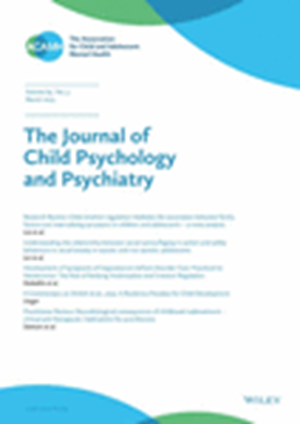The roles of parental verbal communication and child characteristics in the transmission and maintenance of social fears.
IF 7
1区 医学
Q1 PSYCHIATRY
引用次数: 0
Abstract
BACKGROUND Although social anxiety runs in families, little is known about how parents and children contribute to the intergenerational transmission of social fears. We examined whether mothers transfer social fear beliefs to their children through verbal communication and how children's behavioral inhibition and social anxiety contribute to this transmission. The associations of children's social fear beliefs with peer avoidance and interpretation bias were also examined. METHODS Participants (N = 291, 54% female) were followed from toddlerhood to middle childhood. Behavioral inhibition was assessed at ages 2 and 3. At the 10-year assessment, mother-child dyads participated in a conversation task. Mothers received ambiguous information about hypothetical peers and then talked to their children about vignettes involving these peers. Mothers' positive and negative statements were coded. Prior to the conversation, dyads reported their own social fear beliefs. Post-conversation, children rated their social fear beliefs and completed symbolic peer avoidance and social interpretive bias tasks. Children self-reported their social anxiety. RESULTS Mothers' positive statements mediated the paths from maternal social fear beliefs and behavioral inhibition to children's post-conversation social fear beliefs. Mothers' negative statements also mediated the link between mothers' fear beliefs and children's post-conversation fear beliefs, but only among children with heightened anxiety. Children's post-conversation social fear beliefs were, in turn, associated with children's peer avoidance and interpretation bias. CONCLUSIONS Findings suggest that maternal verbal communication serves as a mechanism in the relation between parent and child social fear beliefs, and children's fear beliefs, in turn, predict their symbolic peer avoidance and interpretative biases. Children with heightened anxiety were particularly impacted by their mothers' negative statements, whereas behavioral inhibition predicted fewer maternal positive statements. Targeting mothers' social fear beliefs and verbal communication patterns may help prevent the intergenerational transmission of social fear.父母言语交流和儿童特征在社会恐惧的传递和维持中的作用。
虽然社交焦虑在家庭中存在,但人们对父母和孩子如何促成社交恐惧的代际传递知之甚少。我们研究了母亲是否通过语言交流将社交恐惧信念传递给孩子,以及孩子的行为抑制和社交焦虑如何促进这种传递。儿童的社会恐惧信念与同伴回避和解释偏见的关系也进行了研究。方法从幼儿期至儿童中期随访291例,其中女性占54%。在2岁和3岁时评估行为抑制。在为期10年的评估中,母子二人组参与了一项对话任务。母亲们得到关于假想同伴的模糊信息,然后和孩子们谈论涉及这些同伴的小插曲。母亲们的积极和消极的陈述被编码。在谈话之前,二人组报告了他们自己的社交恐惧信念。谈话结束后,孩子们对他们的社会恐惧信念进行评分,并完成象征性同伴回避和社会解释偏见任务。孩子们自我报告了他们的社交焦虑。结果母亲的积极陈述在母亲社会恐惧信念和行为抑制对儿童对话后社会恐惧信念的影响路径中起中介作用。母亲的负面陈述也在母亲的恐惧信念和孩子谈话后的恐惧信念之间起到中介作用,但仅适用于焦虑程度较高的孩子。儿童的谈话后社会恐惧信念反过来又与儿童的同伴回避和解释偏见有关。结论母亲言语交际在父母和儿童社会恐惧信念的关系中起着重要作用,而儿童的恐惧信念反过来又预测了他们的象征性同伴回避和解释偏见。焦虑程度高的孩子尤其容易受到母亲消极话语的影响,而行为抑制则预示着母亲积极话语的减少。针对母亲的社交恐惧信念和语言交流模式,可能有助于防止社交恐惧的代际传递。
本文章由计算机程序翻译,如有差异,请以英文原文为准。
求助全文
约1分钟内获得全文
求助全文
来源期刊
CiteScore
13.80
自引率
5.30%
发文量
169
审稿时长
1 months
期刊介绍:
The Journal of Child Psychology and Psychiatry (JCPP) is a highly regarded international publication that focuses on the fields of child and adolescent psychology and psychiatry. It is recognized for publishing top-tier, clinically relevant research across various disciplines related to these areas. JCPP has a broad global readership and covers a diverse range of topics, including:
Epidemiology: Studies on the prevalence and distribution of mental health issues in children and adolescents.
Diagnosis: Research on the identification and classification of childhood disorders.
Treatments: Psychotherapeutic and psychopharmacological interventions for child and adolescent mental health.
Behavior and Cognition: Studies on the behavioral and cognitive aspects of childhood disorders.
Neuroscience and Neurobiology: Research on the neural and biological underpinnings of child mental health.
Genetics: Genetic factors contributing to the development of childhood disorders.
JCPP serves as a platform for integrating empirical research, clinical studies, and high-quality reviews from diverse perspectives, theoretical viewpoints, and disciplines. This interdisciplinary approach is a key feature of the journal, as it fosters a comprehensive understanding of child and adolescent mental health.
The Journal of Child Psychology and Psychiatry is published 12 times a year and is affiliated with the Association for Child and Adolescent Mental Health (ACAMH), which supports the journal's mission to advance knowledge and practice in the field of child and adolescent mental health.

 求助内容:
求助内容: 应助结果提醒方式:
应助结果提醒方式:


